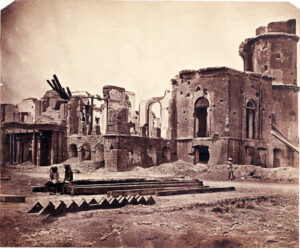Farrell’s picnic in The Siege of Khrishnapur siege is purposely mischaracterized as entertainment for local Indians watching Sepoys attack the official Residency of the East India Company’s residence. It’s a fictional addition to a historical siege lasting five months until the British army rescued the Residency, which had a fifty percent mortality rate. 
Inside the Residency, 1700 British staved off waves of attacks. Outside the Residency, a “cheerful and multifarious crowd assembled every day beneath awning, tents, and umbrellas to watch the feringhhees [foreigners with white skin] fighting for their lives.”
Expecting the Residency‘s imminent fall, a vast crowd arrived “ from all over the district, as to a fair or festival; there was music and dancing; beyond the noise of the guns, the garrison could hear the constant sighing of native instruments, of flutes and sitars, accompanied by finger-drums; there were merchants and vendors of food and drink, nuts, sherbets, and sugarcane . . . sometimes a caprice of the wind would torment the garrison with a spicy smell of cooking chicken as a relief of from the relentless smell of putrefaction. . . in addition there were the ryots [peasant farmers] from the indigo plantations, there were peasants from the village, the traveling holy men, the cargoes of veiled Mohammedan women, the crowds from the Khrishnapur bazaars and even one or two elephants carrying local zemindars [land owners], surrounded like Renaissance princes with liveried retainers.
Krishnapur is based his narrative on the sieges of Cawnpore and Lucknow. Until the Mutiny, both were thriving cities. War correspondent William Howard Russell quotes a military man about the peaceful life of Cawnpore, “Ah! You should have seen Cawnpore in its palmy days when there were two cavalry regiments here, a lot of artillery, and three regiments of infantry in the cantonments. Chock full of pretty women! The private theatricals every week; balls, and picnics, and dinners every evening. By Jove! It’s too horrible to look at it now!”
*Company ruled India for profit. As a result of the Mutiny, the British government relieved the Company of its monopoly and assumed control of India until its independence in 1950.
Featured Image: War in the Lucknow Residence. Louis William Desanges. Surgeon Anthony Dickson Home and Assistant Surgeon William Bradshaw, 90th Regiment of Foot (Perthshire Volunteers) (Light Infantry), Lucknow, 1857. Oil on canvas, by 1860c., https://www.nam.ac.uk/online-collection//images/960/1015000-1015999/1015855.jpg

